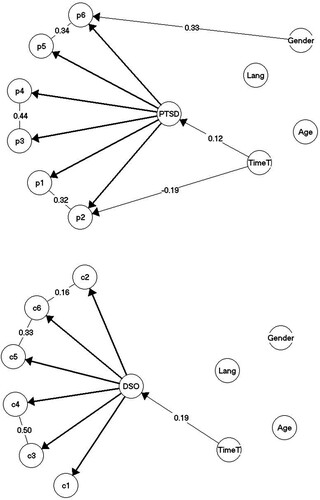Figures & data
Table 1. Demographic characteristics of the study sample.
Table 2. Type and prevalence of traumatic events in the study sample.
Table 3. Percentage distribution of responses to post-traumatic stress disorder (PTSD) and disturbances in self-organization (DSO) items of the International Trauma Questionnaire (ITQ).
Table 4. Distribution of degree of interpreter assistance provided to patients within language groups.
Figure 1. Final graphical log-linear Rasch models for the post-traumatic stress disorder (PTSD) scale (top) and the disturbances in self-organization (DSO) scale (bottom). Note: γ-correlations are partial Goodman and Kruskal’s rank correlations for ordinal data. Lang, language versions; TimeT, time since trauma exposure.

Table 5. Global tests of homogeneity and invariance for the post-traumatic stress disorder (PTSD) and disturbances in self-organization (DSO) scales under the Rasch model (RM) and final graphical log-linear Rasch model (GLLRM).
Table 6. Conversion of post-traumatic stress disorder (PTSD) raw scores to weighted maximum likelihood estimates of person parameters and adjustment of the raw score for differential item functioning (DIF) relative to gender and time since trauma, in (A) men and (B) women.
Table 7. Conversion of disturbances in self-organization (DSO) raw scores to weighted maximum likelihood estimates of person parameters.
Table 8. Comparison of observed and differential item functioning (DIF)-adjusted mean post-traumatic stress disorder (PTSD) scores for groups defined by gender and time since trauma.
Table 9. Targeting and reliability of the post-traumatic stress disorder (PTSD) and disturbances in self-organization (DSO) scales.
Supplemental Material
Download PDF (948.9 KB)Data availability statement
Data can be made available for research purposes upon reasonable request to the corresponding author.
